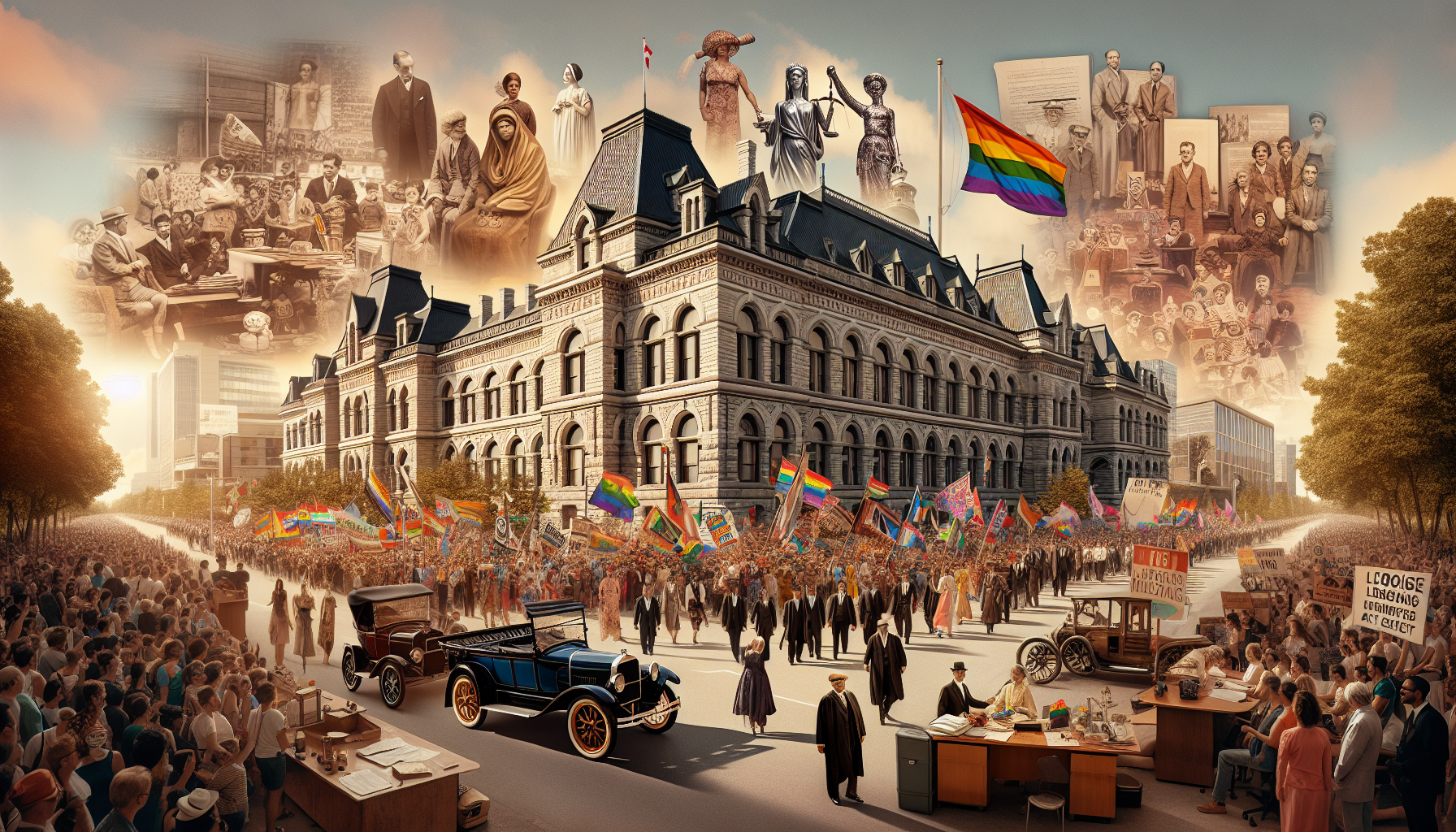Pride Canada: Legal Landmarks and Pride Month Celebrations

On May 31, 2024, the Toronto Mayor, Olivia Chow officially proclaimed June to be Pride Month in the city and raised the Progress Pride flag at the Toronto City Hall. Looking at Pride Canada as whole, we embrace the vibrant colours of diversity, unity, and freedom that paint the landscape of our nation every June during Pride Month. This celebration is not just a tribute to the progress we’ve made but a reminder of the continued journey towards equality and acceptance for the LGBTQ+ community. As we gear up to celebrate, it’s crucial to reflect on the legal milestones and societal strides that have marked this journey. Pride Month is a testament to the resilience and strength of the LGBTQ+ community, and it serves as a beacon of hope for future generations.
Not as many people know about the origins of Pride Month. It began as a commemoration of the Stonewall Riots in 1969, a series of protests in New York City that ignited the modern LGBTQ+ rights movement. These events sparked a wave of activism and paved the way for the progress we see today.
In our exploration of Pride Canada, we will delve into the historical milestones that have shaped Pride Month, the evolution of legal rights for the LGBTQ+ community, and the influential legal cases that have paved the way for change. Join us as we journey through the pivotal moments that have contributed to the vibrant tapestry of Pride Canada.
Historical Milestones in Pride Month
In the 1950s and 1960s, Canada witnessed a significant surveillance and purging of homosexuals from government and military positions, driven by the belief that their presence posed a national security threat. This period marked a dark chapter in the history of LGBTQ+ rights in Canada. However, a pivotal moment occurred on May 14, 1969, when homosexuality was decriminalized following the passage of the Criminal Law Amendment Act, spearheaded by Justice Minister Pierre Trudeau. This act was a crucial step forward, acknowledging the privacy rights of individuals and beginning the process of removing systemic barriers against the LGBTQ+ community.
Early Protests and Marches
The first major public demonstration for gay rights in Canada occurred on August 28, 1971, with activists gathering at Parliament Hill in Ottawa to demand equal rights and protections. This event, alongside smaller protests in cities like Vancouver, signaled the burgeoning of a more visible and vocal LGBTQ+ rights movement in Canada.
Notable Legal Changes and Decriminalization
Decriminalization in 1969 marked the beginning of a series of legal reforms that transformed the landscape of LGBTQ+ rights in Canada. Notably, in 1977, Quebec became the first province to include sexual orientation in its Human Rights Code, setting a precedent for anti-discrimination laws across the country.
Key Events and Activism in the 70s and 80s
The 1981 Toronto bathhouse raids galvanized the LGBTQ+ community, leading to mass protests and the establishment of annual Pride celebrations in the city. This period also saw significant activism that led to the inclusion of sexual orientation under the Canadian Charter of Rights and Freedoms in 1985, further cementing the legal rights and protections for the LGBTQ+ community in Canada.
Evolution of Legal Rights for the LGBTQ+ Community
Decriminalization and Initial Legal Struggles
Since the late 1960s, the LGBTQ+ community in Canada has experienced significant legal advancements starting with the decriminalization of homosexuality. This change was catalyzed by the imprisonment of Everett George Klippert and the subsequent reform led by Justice Minister Pierre Trudeau with Bill C-150 in 1969, which decriminalized gay sex. Progress continued as provinces like Quebec and Ontario incorporated sexual orientation into their Human Rights Codes during the 1970s and 1980s.
Progress in Legal Adoption and Marriage Rights
The legal landscape saw further evolution with the adoption of the Charter of Rights and Freedoms in 1982, which set the stage for future equality rulings. Notable progress in marriage rights began with court rulings in 2003 that recognized the rights of same-sex couples, culminating in the enactment of the Civil Marriage Act in 2005, making Canada the fourth country globally to legalize same-sex marriage.
Recent Developments and Protections
Recent years have witnessed continued advancements in legal protections for the LGBTQ+ community. Landmark decisions, such as the Vriend v. Alberta case in 1998, have solidified anti-discrimination protections. Additionally, the Supreme Court’s ruling in M v. H in 1999 and subsequent federal statutes have further aligned Canadian law with principles of equality and non-discrimination for same-sex couples.
Influential Legal Cases and Their Impact
Landmark Cases and Decisions
Influential legal cases have been pivotal in advancing LGBTQ+ rights in Canada. The Little Sisters Bookstore case highlighted systemic issues with Canada Customs, leading to significant discussions about freedom of expression and discrimination based on sexual orientation. Similarly, the Vriend case was crucial as the Supreme Court of Canada recognized the omission of sexual orientation in Alberta’s human rights laws as discriminatory, setting a precedent for inclusivity.
Influence on Public Perception and Legislation
These cases have not only shaped legal frameworks but also influenced public perception, fostering a broader acceptance and understanding of LGBTQ+ rights. The legislative changes following these decisions have gradually aligned Canadian laws with the principles of equality and non-discrimination, demonstrating the power of judicial influence in societal transformation.
Long-term Effects on LGBTQ+ Rights
The long-term effects of these landmark decisions have been profound. They have facilitated a more inclusive environment, where subsequent legal protections and recognitions, such as same-sex marriage and anti-discrimination laws, could be established, ensuring that the rights of LGBTQ+ individuals are upheld and respected across Canada.
The Role of Activism and Community Efforts
We recognize the profound impact of grassroots movements in shaping the landscape of LGBTQ+ rights in Canada. From the historic 1971 protest at Parliament Hill, where individuals braved the rain to demand equal rights, to the vibrant Pride Week of 1973 that spanned multiple cities with an array of events, these efforts have been pivotal. The role of parades and festivals cannot be overstated; they not only celebrate diversity but also solidify community bonds and visibility. However, challenges persist, requiring ongoing advocacy to address inequalities and ensure the well-being of LGBTQ+ individuals. This continuous fight highlights the enduring significance of community resilience and activism.
Conclusion
Through the collective journey of activism, legal reforms, and societal change, Canada has emerged as a leader in the advancement of LGBTQ+ rights, demonstrating the critical role of resilience, advocacy, and unity within the community. The evolution from decriminalization to the celebration of Pride across the nation encapsulates a significant transformation in societal attitudes and legal frameworks, showcasing a move towards inclusivity and equality. However, the path to equality is ongoing, underscoring the need for continuous efforts to address existing challenges and ensure that the rights and dignity of every individual are respected.
As we celebrate Pride Month and reflect on the milestones achieved, it’s essential to recognize the broader implications of these advances for not only the LGBTQ+ community but also society as a whole. The journey of Pride Canada is a testament to the power of perseverance, the importance of legal and social reforms, and the enduring spirit of the community. It is a call to action for all of us to contribute to sustaining this momentum, advocating for further changes, and embracing the diversity that strengthens the fabric of our nation.

Leave A Comment